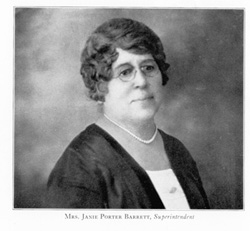| The Library of Virginia >> Exhibitions >> Working Out Her Destiny | ||
 |
||
| Notable Virginia Women - Janie Porter Barrett (1865–1948) | ||
|
Introduction Where are the Women: |
|
Return to Notable Virginia Women Two remarkable women of the same surname, Janie Porter Barrett and Katherine Harwood Waller Barrett, who were about the same age, but unrelated to each other, had parallel careers in education and social work. |
|
In 1908 Barrett became a founder of the Virginia State Federation of Colored Women's Clubs, an affiliate of the influential National Association of Colored Women. During the 1910s she forged important creative alliances with members of the parallel white women's organizations in Virginia, particularly with Mary-Cooke Branch Munford, a Richmond social leader who worked for improvements in public education for children of both races. Their cooperation and the assistance of such business leaders as Richmond banker Maggie Lena Walker led to the Virginia Federation's 1914 purchase of a farm in Hanover County to provide safe housing, medical care, and job training for unmarried young black women and their children. Barrett managed the innovative and successful Virginia Industrial School for Colored Girls from 1915 until her retirement in 1940, by which time it had become part of the state system of schools for poor and needy girls. She boldly used her influential position to advocate black voting and participation in government years before the civil rights movement. Two years after her death on 27 August 1948, the General Assembly named the Hanover County school after her. |
||
